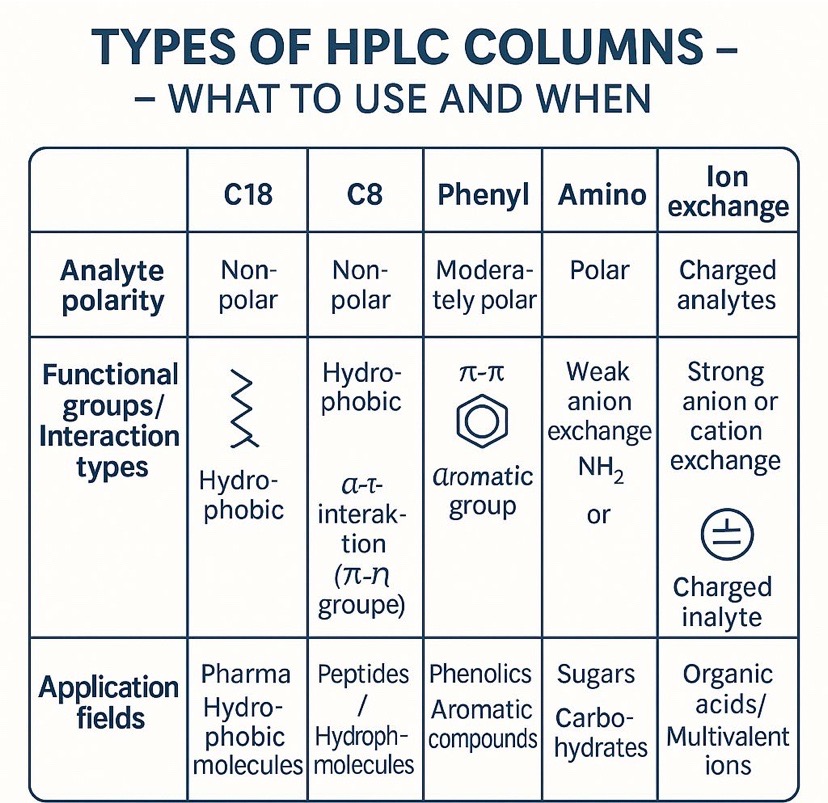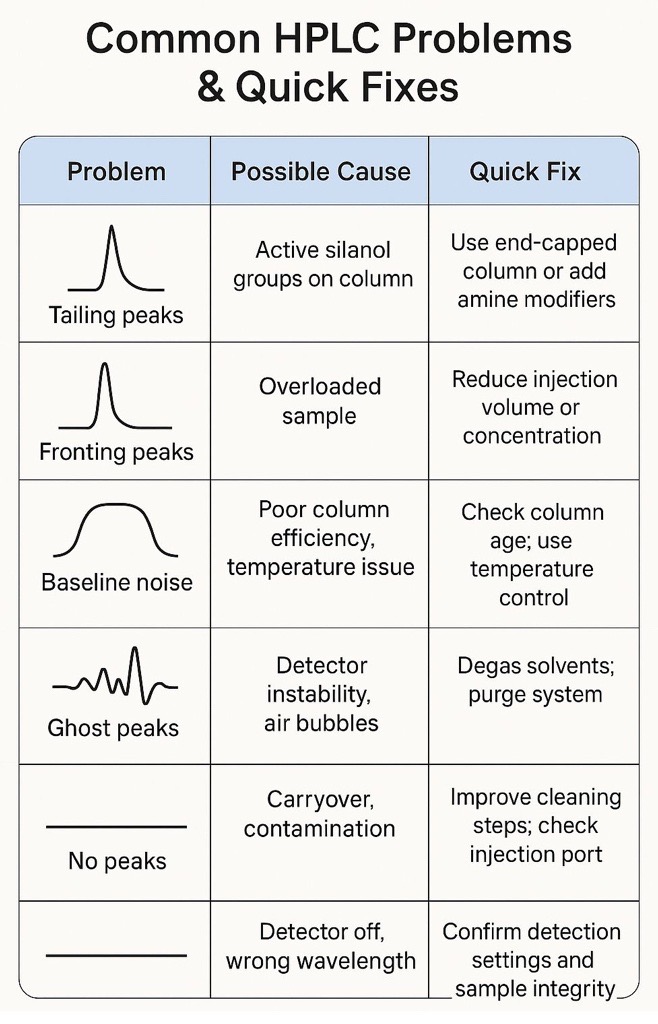Questions
No answers yet.
I wont method of assay the Enilcanzol in HPLC
1- Mobile phase
2- Parameter
3_ Colum
4- preparation of sample and standard
No answers yet.
Types of Band broadening in hplc
No answers yet.
1. Pump Calibration
Q1. What is the acceptance criterion for flow rate accuracy?
A1. The flow rate should be within ±2.0% of the set value.
Q2. How is flow rate accuracy measured in HPLC?
A2. By collecting HPLC grade water in a calibrated volumetric flask and recording the time to fill a known volume using a stopwatch. Flow rate = Volume (mL) / Time (min).
Q3. What is the acceptance criterion for flow rate consistency?
A3. The %RSD of retention time of caffeine should be NMT 1.0%.
Q4. How is flow rate consistency evaluated?
A4. By injecting 10 ppm caffeine solution six times and calculating the %RSD of the retention times.
Q5. What is meant by compositional accuracy?
A5. It refers to the accuracy of gradient composition delivery. Measured using 0.25% acetone in water and recording absorbance changes.
Q6. What is the delay volume limit for the pump system?
A6. The delay volume should be NMT 1.0 mL.
---
2. Autosampler Calibration
Q7. What is the acceptable range for injection volume accuracy?
A7. The average volume for 10 injections should be 20 ± 0.4 µL.
Q8. How is injection volume accuracy determined?
A8. By weighing the HPLC vial before and after 10 injections and using the difference to calculate average injection volume.
Q9. What is the limit for injection volume precision?
A9. %RSD should not be more than 1.0%.
Q10. How is injection volume linearity evaluated?
A10. By injecting 5, 10, 20, 50, and 100 µL and plotting the peak area vs. volume. R-square should be NLT 0.9990.
Q11. What is the acceptance criterion for autosampler temperature?
A11. The measured temperature should be within ±2°C of the set temperature.
---
3. Column Oven Calibration
Q12. What are the required set temperatures for column oven calibration?
A12. 60°C, 50°C, 30°C, 20°C, and 10°C.
Q13. What is the acceptance limit for column oven temperature accuracy?
A13. The measured temperature should be within ±2°C of the set temperature.
Q14. How is the temperature measured?
A14. Using a calibrated probe with a digital thermometer.
---
4. Detector Calibration
Q15. How is wavelength accuracy evaluated?
A15. Using known UV maxima and minima, such as Maxima 273 ± 2 nm, Maxima 205 ± 2 nm, and Minima 245 ± 2 nm.
Q16. What is the acceptance criterion for detector linearity?
A16. R-square (correlation coefficient) should be NLT 0.9990.
Q17. What is the typical injection volume used for detector calibration?
A17. 10 µL.
Q18. What is the standard mobile phase composition for calibration?
A18. Methanol:Water (50:50 v/v).
No answers yet.
No answers yet.

No answers yet.
Hi there
We have shimdazu lab solution softwear . Where signal to ratio calculation is difficult.
Someone who can guide how to calculate ?
Activate QC parameters in METHOD drop down menù. Select noise and drift and set critiria. Normally i use ASTM for noise and save the method, then start a run without injection (-1 in the batch vial position). In the browser open the data file, drag over the method. In a drop down menù you find execute QC and noise drift report in created with resulta pass o fail. there are other method to obtail noise drift calculation in labsolutions software but this is the simplest
In Lab solutions to calculate signal by noise ratio first integrate blank and use the option in integration parameters select the option of signal and drift select the usp not astmand save.
after blank integrate the analyte and keep the spectral reference data of blank it automatically provide the s/N
Can we do custom calculations with Shimadzu Lab solutions software? If yes what are the steps to be followed?
No answers yet.
Someone has to work with condroitín and Glucosamine sulfato, HPLC PDA 195 nm ?
No answers yet.
What is the possible causes that affect peak to valley ratio?
Standard preparation? System? Column?
But I'm using a new column
mostly caused by poor column. maybe you probably injected too much sample which exceeded the capacity of the column.
if you r using new columns the wrong standard preparation and in few cases if system is not in good condition.
Does anyone know the perfect mobile phase for zoledronic acid peak detection in hplc?
Mode: LC
Detector: UV 266 nm
Column: 4.1-mm x 25-cm; packing L21
Column temperature: 35°
Flow rate: 1 mL/min
Injection size: 50 uL
System suitability
Sample: Standard solution
Suitability requirements
Capacity factor: NLT 2.0
Reiative standard deviation: NMT 2.0% for replicate
injections
Analysis
Samples: Standard solution, Sample solution, and Blank
Calculate the percentage of the label claim in the portion
of C4H13NO7P2 taken:
Result =(r u/rs) x (Cs/Cu) > (Mr1/M2) x 100
ru peak area from the Sample solution
rs peak area from the Standard solution
Cs concentration of anhydrous USP Alendronate
Sodium RS in the Štandard stock solution
(mg/mL)
Cy nominal concentration of alendronic acid in the
Sample stock solution (mg/mL)
Mni molecular weight of alendronic acid, 249.10
Mi2 = molecular weight of anhydrous alendronate
sodium, 271.09
Acceptance criteria: C4H12NNaO7P2 equivalent to
90.6%~110.0% of the labeled amount of C 4H13NO7P2
Use alendronic acid USP MONOGRAPH
ASSAY
• PROCEDURE
Solution A: 14.7 g/L of sodium citrate dihydrate and 7.05
g/L of anhydrous dibasic sodium phosphate in water.
[NOTE-Adjust with phosphoric acid to a pH of 8.0 before
bringing the solution to volume.]
Solution B: 38.1 g/L of sodium borate in water
Solution C: 1 mg/mL of 9-fluorenylmethyl chloroformate in
acetonitrile. [NOTE--Prepare this solution fresh just before
use.]
Mobile phase: Acetonitrile, methanol, and Solution A
(20:5:75)
Diluent: 29.4 g/L of sodium citrate dihydrate in water
Standard stock solution: 0.03 mg/mL of anhydrous alen-
dronate sodium in Diluent, from USP Alendronate Sodium RS
Standard solution: Transfer 5.0 mL of the Standard stock
solution to a 50-mL polypropylene screw-cap centrifuge tube
containing 5 mL of Solution B, and mix for 3 min. Add mL
of Solution C, and agitate for 30 s. Allow the solution to
stand at room temperature for 25 min. Add 25 mL of meth-
ylene chloride, and agitate for 40 s. Centrifuge the mixture
for 10 min. Use the clear upper aqueous layer.
Sample stock solution: Transfer NLT 10 Tablets to a 1000-
mL'volumetric flask. Add 500 mL of Diluent, shake by me-
chanical means for 30 min, and sonicate for 5 min. Dilute
with Diluent to volume, and centrifuge a portion of this solu-
tion. Quantitatively dilute a portion of the clear supernatant
to a concentration of 0.02-0.03 mg/mL of alendronic acid.
Sample solution: Transfer 5.0 ml of the Sample stock solu-
tion to a 50-mL polypropylene screw-cap centrifuge tube
containing 5 ml of Solution B, and mix for 3 min. Add 4 ml
of Solution C, and agitate for 30 s. Allow the solution to
stand at room temperature for 25 min. Add 25 mL of meth-
ylene chloride, and agitate for 40 s. Centrifuge the mixture
for 10 min. Use the clear upper aqueous layer.
Blank: Transfer 5 mL of Diluent to a 50-mL polypropylene
screw-cap centrifuge tube containing 5 ml of Solution B,
and mix for 3 min. Add 4 mL of Solution C, and agitate for
30 s. Allow the solution to stand at room temperature for
25 min. Add 25 mL of methylene chloride, and agitate for
40 s. Centrifuge the mixture for 10 min. Use the clear upper
aqueous layer.

Why does baseline noise occur and how can it be minimize?
✅ 1. Detector-related causes:
Lamp instability: UV or DAD detectors depend on a stable light source; an aging or unstable lamp will cause noise.
Detector cell contamination: Dirty flow cell → light scattering → increased noise.
Temperature fluctuations inside the detector (especially in refractive index detectors).
✅ 2. Mobile phase-related causes:
Impurities in solvents: Even high-purity solvents may contain UV-absorbing impurities.
Air bubbles: Entrained gases passing through the detector cause spikes or drifting noise.
Incomplete degassing of mobile phase.
✅ 3. System-related causes:
Pump pulsation: Mechanical inconsistencies cause pressure and flow fluctuations → noise.
Leaks or loose fittings → flow instability → noisy baseline.
Column issues: Damaged or contaminated columns may cause unstable baseline.

Types of HPLC Columns –What to Use and When
Column choice isn't just about C18! ?
From amino to phenyl, each stationary phase brings something unique to your separation.
✅ Here's a visual guide to help you choose the right column based on:
• Analyte polarity
• Functional groups
• Interaction types
• Application fields (e.g., sugars, peptides, phenolics, pharmaceuticals)
? Choosing the wrong column can cost you resolution, time, and sample integrity. Don’t waste injections — get it right the first time!
? What’ss your favorite go-to column, and what do you use it for?
Post by Ahmed Newehy
C18 classical and friendly hahaahha
Does anyone know where I can get some application notes for Vitamin D in wheat flour or similar matrices?
No answers yet.
Pressure fluctuation in hplc..
Causes..??
How to correct..?
check the system for air bubbles or leakage
Bad purge between primary and accumulator plungers. or maybe a leak. check all tubing and connections
bubbles on your system, because bad purgue o review bottle mobile phase
I have been observing the rare seal leakage while running thermo ultimate 3000 series. Whats the solution to it? How we can rectify it ? Why does it occuring always ? Please anyone explain me in detail
No answers yet.


